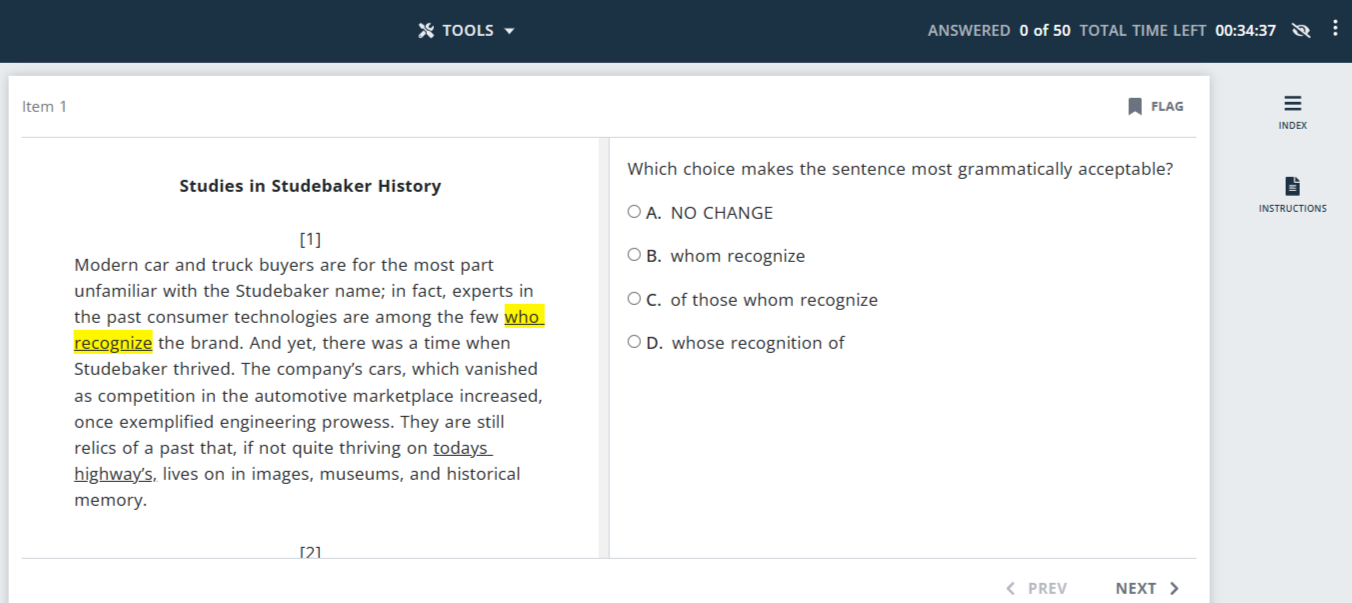




Key Takeaways
- ACT English tests predictable grammar rules—mastering them boosts confidence and scores.
- Strong grammar skills save time for tougher rhetorical questions.
- Tutors should emphasize clarity, consistency, and concise rule application.
The ACT English section tests both grammar and rhetorical skills, but grammar rules tend to draw the strongest reactions. Some students think the rules are obvious and easy, while others feel overwhelmed by the sheer number they’ll need to know. In reality, both views miss the mark.
The English section can be challenging because it covers grammar, punctuation, usage, and style. Even native speakers can’t rely on instinct alone. At the same time, the number of grammar rules the ACT actually tests is limited and predictable. With clear instruction and consistent practice, students can make significant improvements in this section.
This article consolidates the most important ACT grammar rules tutors should emphasize. Before diving into the specifics, let’s briefly look at why grammar is such a critical part of the ACT English test.
Why grammar matters in the ACT English section
Strong grammar skills play a central role in ACT success. In fact, grammar and usage questions make up a significant portion of the English section, meaning students who master these rules can raise both their sectional and overall scores. Here’s a detailed explanation of how ACT scores are calculated.
Solid grammar performance also signals that a student understands and can apply standard English conventions—something admissions officers expect.
Another advantage: grammar questions are usually shorter and quicker to answer than rhetorical skills questions. This allows students to save valuable time for more complex passages later in the section. And since English is the very first section on the ACT, starting strong can provide a major confidence boost.
Look at the following screenshot from a simulated ACT. Such questions save time that students can use for the other questions in this section.

The good news is that many mistakes students make arise from haste or incomplete understanding of the fundamental ACT English grammar rules. You, as a tutor, can easily help your students gain points with some useful tips.
Understand the ACT grammar rule types
Before diving into technical classifications, it’s useful to show students that some sentences can only be corrected with a clear grasp of grammar rules.
For example:
Incorrect: Chloe and Rachel is classmates.
Correct: Chloe and Rachel are classmates.
Without knowing subject–verb agreement, it’s hard to spot the problem.
Other times, logic helps. Consider: “Having committed over a dozen armed robberies, the police began a nation-wide hunt for Butch Cassidy.”
Ask two questions:
- Who committed the robberies? (Butch Cassidy)
- Who began a nation-wide hunt? (The police force)
Since the answers don’t align, the sentence is incorrect.
To make lesson planning easier, ACT grammar rules can be grouped into two categories:
Group 1: core grammar rules
These require a solid understanding of grammar fundamentals.
1. Punctuation rules: commas, semicolons, colons, apostrophes
Example: Students often confuse its (possessive) with it’s (it is/it has).
2. Subject-verb agreement: Ensuring subjects and verbs match in number.
Example:
- Incorrect: Kevin, Maria, and Phil is late for basketball practice.
- Correct: Kevin, Maria, and Phil were late for basketball practice.
However, the ACT will complicate it by lengthening the sentence and introducing unnecessary details.
3. Pronoun clarity and consistency
Pronouns must clearly refer to one noun.
Example: “When Sarah gave Anne a book, she was happy.”
Since both Sarah and Anne are females, the pronoun “she” doesn’t tell us who was happy, Sarah or Anne?
4. Verb tenses and verb forms
Verbs must stay consistent within the time frame.
Example:
- Incorrect: Aanya walked into the room and notices the mess.
- Correct: Aanya walked into the room and noticed the mess.
Group 2: stylistic and rhetorical rules
These depend on logic, placement, and sentence flow.
5. Modifiers and parallel structure
Descriptions must be placed correctly, and lists should follow a consistent format.
Example:
- Incorrect: Tall, dark, and handsome, the audience loved the new movie star.
- Correct: The audience loved the new movie star, who was tall, dark, and handsome.
6. Idiomatic expressions
Idiomatic expressions add flavor to the language, typically substituting one phrase for another and yet conveying the meaning. Here, for instance, the phrase “water under the bridge” means a lot of time has passed.
Example: A lot of water has flown under the bridge since the Great Age of Seafarers.
7. Transitions and sentence flow
Words like however, yet, and therefore must match the logic of the sentence.
Example:
- Incorrect: Caleb had worked hard for the test, yet he topped his class.
- Correct: Caleb had worked hard for the test, so he topped his class.
11 Essential ACT grammar rules tutors should teach
To help your students strengthen their ACT English performance, here are 11 key grammar rules tutors should focus on during sessions and in practice assignments. In the overall design of the new ACT format, mastering these rules will help your students quickly improve their scores—and confidence too.
Rule 1: comma vs. semicolon usage
One of the most frequent student challenges is deciding whether a comma or semicolon is appropriate. The distinction becomes clear once they understand independent and dependent clauses.
- Independent clause: A complete sentence that can stand alone.
Example: Kate was hungry. - Dependent clause: A sentence fragment that needs more information to be complete.
Example: …because she was looking for a restaurant.
Key teaching point:
- A comma connects the independent clause and the dependent clause.
Example: Kate was hungry, so she looked for a restaurant.
- A semicolon connects two independent clauses.
Example: Kate was hungry; she looked for a restaurant.
Rule 2: its vs. it’s
This rule is a common ACT trap because it blends punctuation with grammar. Students often assume an apostrophe always signals possession—but that’s not true for it.
Key teaching point:
- It’s: a contraction for it is or it has.
Example: While traveling in a desert, it’s (it is) important to stay hydrated. - Its: the possessive form of it.
Example: At night, its (the desert’s) temperature can drop considerably.
💡 Tutor tip:
Encourage students to mentally expand it’s into it is or it has. If the sentence still makes sense, the contraction is correct. If not, the answer must be its.
Rule 3: subject-verb agreement
The ACT often hides subject–verb agreement errors inside long, wordy sentences. Students who get distracted by extra details may incorrectly match the verb to the nearest noun instead of the true subject.
Example:
- Incorrect: The excitement of the players, the coach, and the cheering fans waiting for the home team to lift the cup for the first time were obvious as the team took the field.
- Correct: The excitement of the players, the coach, and the cheering fans waiting for the home team to lift the cup for the first time was obvious as the team took the field.
Here, the true subject is excitement—a singular, uncountable noun—so the verb must be singular (was).
Three-step strategy for students:
- Find the principal subject. (In this case, excitement)
- Decide whether the subject is singular or plural. (excitement is singular)
- Ignore fillers or distractors and match the verb to the subject, not to nearby nouns.
💡 Tutor tip:
Create drills where students cross out prepositional phrases or descriptive clauses. This trains them to focus on the real subject quickly.
Rule 4: misplaced modifiers
Misplaced modifiers are tricky because sentences often sound correct when read quickly. The reader’s brain fills in the intended meaning, even though the grammar says otherwise. Check out the example here:
Example:
- Incorrect: Covered in nuts and sprinkled with candy pieces, Forrest Gump loved the ice cream.
This version mistakenly suggests Forrest Gump was covered in nuts and candy pieces.
- Correct: Forrest Gump loved the ice cream that was covered in nuts and sprinkled with candy pieces.
Key teaching point:
A modifier must sit next to the noun it is describing. If it drifts away, the sentence changes meaning.
💡 Tutor tip:
Train students to:
- Identify the description (modifier).
- Ask, “Which noun does this describe?”
- Check if the modifier is placed directly next to that noun.
Most misplaced modifier errors on the ACT can be fixed by simply rearranging the sentence so the modifier is next to the noun it modifies.
Rule 5: verb tense consistency
Verb tense errors are some of the most common on the ACT, but they’re also among the easiest for students to fix. The rule is straightforward: when describing a series of actions in the same time frame, all verbs must stay in the same tense.
Example:
- Incorrect: Dorothy entered the room, glanced at the portrait, and immediately recognizes the dragon-slayer.
- Correct: Dorothy entered the room, glanced at the portrait, and immediately recognized the dragon-slayer.
Key teaching points:
- A shift in tense mid-sentence is almost always a red flag.
- The ACT often buries the error in longer sentences, so encourage students to check verb endings systematically.
💡 Tutor tips:
- Have students identify the subject and its sequence of actions.
- Confirm whether the actions occur in the same time frame.
- Ensure all verbs match that tense consistently.
Rule 6: consistent pronoun use
Pronoun consistency errors are easy to miss because casual speech often ignores them. On the ACT, however, the rules are strict: pronouns must agree in number with the nouns they replace.
Example:
- Incorrect: Everybody was asked to bring their own lunch.
- Correct: Everybody was asked to bring his or her own lunch.
Here, everybody is a singular indefinite pronoun, so it requires a singular pronoun (his or her)—not the plural their. While everyday English increasingly accepts singular they to avoid gender bias, the ACT expects strict number agreement.
Key teaching points:
- Singular subjects take singular pronouns.
- Plural subjects take plural pronouns.
- The ACT does not allow singular they in these cases.
💡 Tutor tip:
Have students practice by underlining the antecedent (the noun the pronoun refers to). Then check: is it singular or plural? This habit helps catch mismatches quickly.
Rule 7: parallel structure
Also called parallel construction or parallelism, this rule requires that items in a list or series follow the same grammatical pattern. When the structure shifts, the sentence becomes unbalanced and incorrect.
Example:
- Incorrect: In olden days, the chief duties of a woman were washing, cleaning, cooking, and to take care of the children.
- Correct: In olden days, the chief duties of a woman were washing, cleaning, cooking, and taking care of the children.
Here, three items use the -ing form, but the last uses an infinitive (to take), breaking the pattern.
Key teaching point:
Parallelism is often tested in:
- Lists: She likes reading, writing, and painting.
- Comparisons: He prefers hiking to swimming.
- Multiple actions: The teacher explained the rule, gave examples, and assigned practice problems.
💡 Tutor tip:
Encourage students to first check for lists of actions or ideas. If one part doesn’t “match” the others grammatically, it’s almost always a parallelism error.
Rule 8: apostrophes in possessives
Possessive apostrophes are a common ACT punctuation test point. Teaching this alongside other punctuation rules helps students see patterns more clearly.
Key rules to teach:
- Singular noun: add ’s
Example: Rebecca’s journal (the journal belongs to Rebecca). - Plural noun ending in s: add ’ after the s
Example: the teachers’ training (the training of the teachers).
Irregular plural noun (not ending in s): add ’sExample:the children’s books (the books of the children).
Special note: Non-living objects usually don’t take possessive apostrophes in formal English. Instead, the “of” construction is preferred.
- Preferred: the color of the table
- Not preferred: the table’s color
💡 Tutor tip:
Point out that ACT questions often test possessive placement within longer noun phrases. Have students practice spotting whether the possessive form logically refers to the correct noun.
Rule 9: that vs. which
The ACT often tests whether students can distinguish between restrictive and non-restrictive clauses. The choice between that and which depends on whether the clause is essential to the sentence.
Key teaching points:
- That: introduces a restrictive clause (essential to the meaning).
- No commas are used.
- Example: Books that have pages missing are not fun to read.
(Only books with missing pages are excluded. Other books may still be fun.)
- No commas are used.
- Which: introduces a non-restrictive clause (extra information).
- Commas are required.
- Example: The book, which has a red cover, is on the table.
(The clause adds detail, but the sentence is still correct without it: The book is on the table.)
- Commas are required.
💡 Tutor tip:
Have students test the sentence by removing the clause:
- If the sentence’s meaning changes → use that.
- If the sentence still makes sense → use which
Rule 10: wordiness: Concise is better
The ACT often tests concision by adding redundant words or phrases that make a sentence unnecessarily long. Students should be trained to prefer clarity and brevity, as long as the meaning remains intact.
Example:
- Incorrect: Due to the fact that the professor was late, we had to leave.
- Correct: Because the professor was late, we had to leave.
Another example:
- Incorrect: The children were happy and joyful.
- Correct: The children were happy.
Key teaching points:
- Always choose the shortest grammatically correct option that preserves the meaning.
- Watch for phrases with the same meaning (e.g., past history, unexpected surprise, each and every).
💡 Tutor tip:
Encourage students to treat wordiness as a “red flag.” If two answer choices look grammatically correct, the more concise one is usually right on the ACT.
Rule 11: two additional rules
a) Improper comparisons
Comparisons must always be between equivalent things. On the ACT, errors often arise when part of the comparison is missing or illogical.
- Incorrect: The lions of Kenya are darker than Egypt.
(This compares lions to a country.) - Correct: The lions of Kenya are darker than those of Egypt.
(Now the comparison is between lions and lions.)
💡 Tutor tip:
Have students check that both sides of the comparison match in form and meaning.
b) Question tags
A question tag must match the auxiliary (helping) verb and subject in the main sentence.
- Incorrect: Jay can play the piano, isn’t it?
- Correct: Jay can play the piano, can’t he?
💡 Tutor tip:
Point out that question tags are rare on the ACT but can trip up students unfamiliar with the rule. Teach them to focus on matching the helping verb (can, will, should, etc.) and subject.
8 tips to reinforce grammar rules effectively
Here are the eight most important tips to make sure your students learn and remember the important rules of ACT English grammar.
- Use mini grammar drills. Assign short, focused exercises on just one rule at a time to build mastery.
- Mix the rules. After learning rules individually, give mixed-review sets to test recognition in real test conditions.
- Work with accurate ACT practice tests. That will show your students what the actual ACT covers.
- Highlight clue words. Train students to spot clue words (like "because," "that," or modifiers) that often signal a rule being tested.
- Explain to understand. Ask students to explain or “teach back” the rule. Teaching reinforces comprehension and reveals lingering confusion.
- Use flashcards. Flashcards or index cards provide quick, repetitive exposure to rules and examples, making them an efficient revision tool.
- Track error patterns. Review past mistakes to identify which rules need more attention and tailor practice accordingly. Use EdisonOS’s analytics to make tracking errors reliable and quick.
- Gamify practice. Add fun with activities like “spot the error” races or timed challenges. A little competition helps keep grammar reviews lively and engaging.
Teaching ACT grammar doesn’t have to be boring
Teaching ACT English grammar rules can feel tricky—some rules are straightforward, while others depend on context. Students may even find multiple “possible” corrections, which can add to the challenge.
It is this variety that tutors can leverage to turn grammar sessions into interactive, focused, and high-impact learning experiences. Tutoring can turn those sessions into high-impact, score-boosting sessions.
A platform like EdisonOS makes this process easier. Tutors can assign targeted grammar practice, track rule-specific error patterns, and create personalized retention plans. As students see measurable progress in quizzes and practice tests, grammar review shifts from tedious to motivating—making every session both effective and engaging.
Ready to see how EdisonOS can streamline your ACT tutoring? Book a demo today!
Frequently asked questions

Tutors Edge by EdisonOS
in our newsletter, curated to help tutors stay ahead!
Tutors Edge by EdisonOS
Get Exclusive test insights and updates in our newsletter, curated to help tutors stay ahead!
Recommended Reads
Recommended Podcasts






.png)




.png)
.webp)
